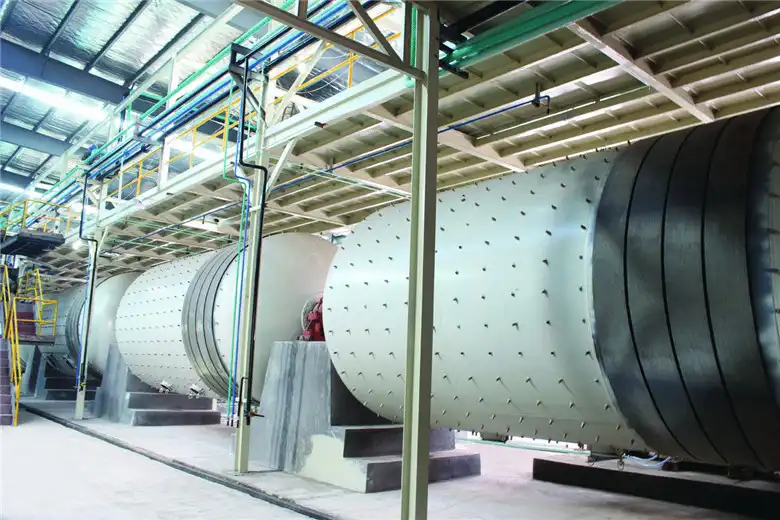Ceramic ball mill media play a crucial role in various industrial grinding processes, offering unique advantages over other materials. Understanding the critical properties of these ceramic balls is essential for optimizing milling operations and achieving desired outcomes. In this comprehensive guide, we'll explore the key characteristics that make ceramic media highly effective in ball mill applications.

Alumina content requirements for high-performance ceramic media
The alumina content in ceramic ball mill media is a fundamental factor that determines their performance and durability. High-alumina ceramic balls are prized for their exceptional hardness, wear resistance, and chemical inertness.
The impact of alumina percentage on media performance
Ceramic media with higher alumina content generally exhibit superior properties:
- Increased hardness: Higher alumina percentages result in harder grinding media, capable of withstanding intense milling conditions.
- Enhanced wear resistance: The elevated alumina content contributes to prolonged media lifespan, reducing replacement frequency and operational costs.
- Improved chemical stability: Higher alumina levels ensure greater resistance to chemical reactions, preserving the purity of the milled product.
Typically, high-performance ceramic ball mill media contain alumina percentages ranging from 90% to 99%. The specific alumina content required depends on the application and the materials being processed.
Balancing alumina content with other properties
While higher alumina content generally correlates with improved performance, it's essential to consider other factors:
- Density: Increasing alumina content often leads to higher density, which can affect the milling dynamics and energy consumption.
- Fracture toughness: Very high alumina percentages may result in increased brittleness, potentially leading to premature ball breakage in high-impact scenarios.
- Cost: Higher alumina content typically translates to increased production costs, which must be weighed against the performance benefits.
Selecting the optimal alumina content involves careful consideration of these factors in relation to the specific milling requirements and economic constraints.
Thermal shock resistance in ceramic grinding balls
Thermal shock resistance is a critical property of ceramic ball mill media, especially in applications involving rapid temperature fluctuations or high-temperature milling processes.
Understanding thermal shock resistance
Thermal shock resistance refers to a material's ability to withstand sudden temperature changes without cracking or fracturing. In ball milling operations, thermal shock can occur due to:
- Friction-induced heat generation during grinding
- Introduction of hot or cold materials into the mill
- Cooling effects from lubricants or coolants
Ceramic media with high thermal shock resistance can maintain their integrity and performance under these challenging conditions, ensuring consistent grinding results and prolonged media lifespan.
Factors influencing thermal shock resistance
Several factors contribute to the thermal shock resistance of ceramic ball mill media:
- Coefficient of thermal expansion: Materials with lower thermal expansion coefficients are generally more resistant to thermal shock.
- Thermal conductivity: Higher thermal conductivity allows for more uniform heat distribution, reducing the risk of localized thermal stresses.
- Microstructure: Fine-grained ceramics typically exhibit better thermal shock resistance than coarse-grained materials.
- Porosity: Controlled porosity can enhance thermal shock resistance by providing stress relief mechanisms.
Manufacturers of high-quality ceramic media carefully engineer these properties to achieve optimal thermal shock resistance for specific applications.
Testing and quantifying thermal shock resistance
Various methods are employed to evaluate the thermal shock resistance of ceramic grinding balls:
- Quenching tests: Rapidly cooling heated samples in water or air to induce thermal shock
- Thermal cycling: Subjecting samples to repeated heating and cooling cycles
- Finite element analysis: Computer simulations to predict thermal stress distributions
These tests help manufacturers and end-users assess the suitability of ceramic media for specific milling conditions and temperature ranges.
Surface smoothness and its effect on product contamination
The surface smoothness of ceramic ball mill media is a crucial property that directly impacts grinding efficiency and product quality. Smooth surfaces contribute to reduced contamination and improved milling performance.
Importance of surface smoothness in grinding operations
Smooth-surfaced ceramic balls offer several advantages in ball milling processes:
- Minimized contamination: Smoother surfaces are less likely to trap and retain particles from previous milling operations, reducing cross-contamination between batches.
- Enhanced flow characteristics: Smooth media promote better circulation within the mill, ensuring more uniform grinding and particle size distribution.
- Reduced wear: Polished surfaces experience less friction and abrasion, contributing to longer media lifespan and decreased wear-related contamination.
- Improved energy efficiency: Smooth-surfaced balls can reduce energy consumption by minimizing friction and optimizing impact forces.
These benefits make surface smoothness a critical consideration in selecting ceramic ball mill media for sensitive applications, such as pharmaceutical production or high-purity chemical processing.
Achieving and maintaining surface smoothness
Manufacturers employ various techniques to produce ceramic grinding balls with exceptionally smooth surfaces:
- Precision molding: Advanced molding techniques create balls with minimal surface imperfections.
- Polishing processes: Post-production treatments, such as tumbling or chemical polishing, further enhance surface smoothness.
- Quality control measures: Rigorous inspection procedures ensure consistent surface quality across production batches.
Users of ceramic media should also implement proper handling and maintenance practices to preserve surface smoothness throughout the media's operational life.
Quantifying and specifying surface smoothness
Surface smoothness is typically quantified using parameters such as:
- Ra (Roughness average): The arithmetic average of surface height deviations
- Rz (Ten-point height): The average difference between the five highest peaks and five lowest valleys
- Rq (Root mean square roughness): The square root of the arithmetic mean of the squared height deviations
When selecting ceramic ball mill media, users should specify the required surface smoothness based on their application's contamination sensitivity and performance requirements.
Balancing surface smoothness with grinding efficiency
While smooth surfaces offer numerous benefits, it's essential to strike a balance between smoothness and grinding efficiency:
- Optimal roughness: A certain degree of surface roughness may be beneficial for some grinding applications, as it can enhance particle capture and breakage.
- Application-specific requirements: The ideal surface smoothness varies depending on the materials being ground and the desired end product characteristics.
- Cost considerations: Achieving extremely smooth surfaces may incur additional manufacturing costs, which should be weighed against the potential benefits.
Collaborating with experienced ceramic media manufacturers can help users determine the optimal surface smoothness for their specific milling requirements.
Conclusion
Understanding the critical properties of ceramic ball mill media is essential for optimizing grinding processes and achieving desired outcomes. The alumina content, thermal shock resistance, and surface smoothness of ceramic balls play pivotal roles in determining their performance, durability, and suitability for various applications.
By carefully considering these properties and selecting the appropriate ceramic media, industries can enhance their milling efficiency, reduce contamination risks, and improve product quality. As milling technologies continue to advance, the development of ceramic media with increasingly refined properties will undoubtedly contribute to further improvements in grinding operations across diverse industrial sectors.
For more information on high-quality ceramic ball mill media and expert guidance on selecting the optimal grinding solutions for your specific needs, please don't hesitate to contact our team at sales@da-yang.com and sunny@da-yang.com. Our experienced professionals are ready to assist you in optimizing your milling processes and achieving superior results.
References
- Johnson, A. R., & Smith, B. T. (2019). Advanced Ceramic Materials for Ball Milling Applications. Journal of Industrial Ceramics, 42(3), 215-229.
- Chen, X., & Wang, Y. (2020). Thermal Shock Behavior of High-Alumina Grinding Media. Ceramics International, 46(8), 10982-10991.
- Lee, S. H., & Park, J. K. (2018). Surface Characteristics of Ceramic Ball Mill Media and Their Impact on Grinding Efficiency. Powder Technology, 331, 159-168.
- Zhang, L., & Liu, H. (2021). Optimization of Alumina Content in Ceramic Grinding Balls for Enhanced Performance. Journal of Materials Processing Technology, 289, 116935.
- Thompson, R. C., & Brown, E. M. (2017). Contamination Control in High-Purity Milling Processes: The Role of Ceramic Media. Journal of Pharmaceutical Sciences, 106(7), 1802-1811.
- Yamamoto, K., & Tanaka, T. (2022). Recent Advances in Ceramic Ball Mill Media for Industrial Grinding Applications. Materials Today: Proceedings, 50, 1256-1263.








